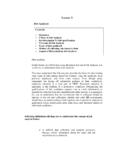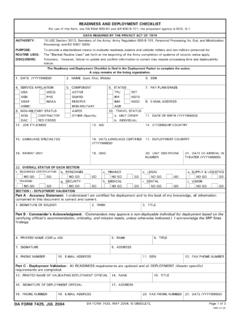Transcription of LESSON: 10 Job Evaluation Learning Objectives - …
1 LESSON: 10 job evaluation learning objectives : 1. To know basic approach to Job Evaluation . 2. To importance of Job Evaluation and its effectiveness. 3. To know the important methods of Job Evaluation . Now friends we will discuss about how jobs used to be evaluated in an organization; if somebody having any idea about it please start explaining it; this can be explained in the following way. Job Evaluation is the process of analyzing and assessing the various jobs systematically to ascertain their relative worth in an organization.
2 Job is evaluated on the basis of their content and is placed in the order of their importance. It should be noted that in a job Evaluation programme, the jobs are ranked and not the jobholders. Jobholders are rated through performance appraisal. Job Evaluation is a process of finding out the relative worth of a job as compared to other jobs Now, who is going to explain the Objectives of job Evaluation ? The following Objectives are derived from the analysis of the above-mentioned definitions: - 1) To gather data and information relating to job description, job specification and employee specifications for various jobs in an organization.
3 2) To compare the duties, responsibilities and demands of a job with that of other jobs. 3) To determine the hierarchy and place of various jobs in an organization. 4) To determine the ranks or grades of various jobs. 5) To ensure fair and equitable wages on the basis of relative worth or value of jobs. In other words equal wages are fixed to the jobs of equal worth or value. 6) To minimize wage discrimination based on sex, age, caste, region, religion etc. How many of you know the principles of job Evaluation programme? Job Evaluation programme should be implemented carefully. The following principles help in successful implementation of the programme: 1.
4 Rate the job but not the employee. Rate the elements on the basis of the job demands. 2. The elements selected for rating should be easily understood. 3. The elements should be defined clearly and properly selected. 4. Employees concerned and the supervisors should be educated and convinced about the programme. 5. Supervisors should be encouraged to participate in rating the jobs. 6. Secure employee cooperation by encouraging them to participate in the rating programme. 7. Discuss with the supervisors and employees about rating but not about assigning money values to the points. 8. Do not establish too many occupational wages.
5 For, better understanding let us look at the flowchart given below: Job Evaluation Process Employee Classification Wage Survey Job Evaluation Programme Job Specification Job Description Job Analysis Objectives of Job Evaluation Job Evaluation Process: The job- Evaluation process starts defining Objectives of Evaluation and ends with establishing wage and salary differentials. The main objective of job Evaluation , as was stated earlier, is to establish satisfactory wage and salary differentials. Job analysis should precede the actual program of Evaluation .
6 Job analysis, as was discussed earlier, provides job-related data, which would be useful in drafting job description and job specification. A job- Evaluation program involves answering several questions: The major ones are: Which jobs are to be evaluated? Who should evaluate the jobs? What training do the Evaluation need? How much time is involved? What should be the criteria for Evaluation ? What methods of Evaluation are to be employed? Which jobs are to be evaluated in any exercise, where there are more than 30 or 40 jobs to be evaluated, it is necessary to identify and select a sample of benchmark jobs, which can be used for comparisons inside and outside the organs.
7 The benchmark jobs should be so selected to achieve representative sample of each of the main levels of jobs in each of the principal occupations. The size of the sample depends on the number of different jobs to be covered. It is likely to be less than about five percent of the total number of employees in the organization and it would be difficult to produce a balanced sample unless at least 25 percent of the distinct jobs at each level of the organization were included. Staffing the Evaluation exercise: A committee, which consists of Head of several of department s, as was pointed out earlier, does representatives of employee unions and specialist drawn from the National Productivity council Job Evaluation .
8 HR specialists will be normally the chairmen of the committee. Responsibility for the overall coordination of the job- Evaluation programme should be in the hands of a senior executive who can then report its progress to the board, and advise it on ensuring wage and salary development. Training for the Committee: Members of the job- Evaluation committee should be trained in its procedure so as to make the program successful. Time Factor: Job Evaluation should not be conducted in haste. Any rushing through will lead to appeals against the grading of jobs. Eight jobs in a day can be the ideal pace.
9 After this, the quality of Evaluation tends to drop, and more time has to spend later in checking and assessing the validity of the grading. The final review of all the time should be allowed for re- Evaluation , if necessary. Isolating Job- Evaluation criteria: The heart of job Evaluation is the determination of the criteria for Evaluation . Most job evaluations use responsibility, skill, effort and working conditions as major criteria. Other criteria used are difficulty, time-span of discretion, size of subordinate staff, and degree of creativity needed. It needs no emphasis that job Evaluation criteria vary across jobs.
10 So friends you must have got a fair idea what is job Evaluation ; now we will discuss what are the methods involved in job Evaluation , Methods of Job Evaluation : Job- Evaluation methods are of two categories-Analytical and Non Analytical Job Evaluation Analytical Non Analytical Point Factor Comparison Ranking Job-grading Banding Method Method Analytical: 1. Point Method Comparison Method Point Method The system starts with the selection of job factors, construction of degrees for each factor, and assignment of points to each degree.








